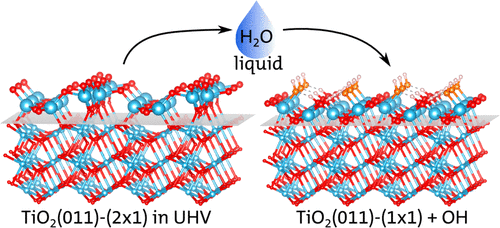当前位置:
X-MOL 学术
›
J. Phys. Chem. C
›
论文详情
Our official English website, www.x-mol.net, welcomes your
feedback! (Note: you will need to create a separate account there.)
Surface Structure of TiO2 Rutile (011) Exposed to Liquid Water
The Journal of Physical Chemistry C ( IF 3.3 ) Pub Date : 2017-11-16 00:00:00 , DOI: 10.1021/acs.jpcc.7b09674 Jan Balajka 1 , Ulrich Aschauer 2 , Stijn F. L. Mertens 1 , Annabella Selloni 3 , Michael Schmid 1 , Ulrike Diebold 1
The Journal of Physical Chemistry C ( IF 3.3 ) Pub Date : 2017-11-16 00:00:00 , DOI: 10.1021/acs.jpcc.7b09674 Jan Balajka 1 , Ulrich Aschauer 2 , Stijn F. L. Mertens 1 , Annabella Selloni 3 , Michael Schmid 1 , Ulrike Diebold 1
Affiliation

|
The rutile TiO2(011) surface exhibits a (2 × 1) reconstruction when prepared by standard techniques in ultrahigh vacuum (UHV). Here we report that a restructuring occurs upon exposing the surface to liquid water at room temperature. The experiment was performed in a dedicated UHV system, equipped for direct and clean transfer of samples between UHV and liquid environment. After exposure to liquid water, an overlayer with a (2 × 1) symmetry was observed containing two dissociated water molecules per unit cell. The two OH groups yield an apparent “c(2 × 1)” symmetry in scanning tunneling microscopy (STM) images. On the basis of STM analysis and density functional theory (DFT) calculations, this overlayer is attributed to dissociated water on top of the unreconstructed (1 × 1) surface. Investigation of possible adsorption structures and analysis of the domain boundaries in this structure provide strong evidence that the original (2 × 1) reconstruction is lifted. Unlike the (2 × 1) reconstruction, the (1 × 1) surface has an appropriate density and symmetry of adsorption sites. The possibility of contaminant-induced restructuring was excluded based on X-ray photoelectron spectroscopy (XPS) and low-energy He+ ion scattering (LEIS) measurements.
中文翻译:

液态水中暴露的TiO 2金红石(011)的表面结构
金红石型TiO 2用超高真空(UHV)中的标准技术制备时(011)表面呈现(2×1)重构。在这里,我们报告说,在室温下将表面暴露于液态水中会发生重组。实验是在专用的特高压系统中进行的,该系统可在特高压和液体环境之间直接和干净地转移样品。暴露于液态水后,观察到具有(2×1)对称性的表层,每个单元格包含两个解离的水分子。在扫描隧道显微镜(STM)图像中,两个OH基团产生明显的“ c(2×1)”对称性。根据STM分析和密度泛函理论(DFT)计算,该覆盖层归因于未重建(1×1)表面顶部的离解水。对可能的吸附结构的研究以及对该结构中域边界的分析提供了有力的证据,表明原始的(2×1)重构得到了解除。与(2×1)重建不同,(1×1)表面具有适当的密度和对称的吸附位点。基于X射线光电子能谱(XPS)和低能He排除了污染物引起的重组的可能性+离子散射(LEIS)测量。
更新日期:2017-11-17
中文翻译:

液态水中暴露的TiO 2金红石(011)的表面结构
金红石型TiO 2用超高真空(UHV)中的标准技术制备时(011)表面呈现(2×1)重构。在这里,我们报告说,在室温下将表面暴露于液态水中会发生重组。实验是在专用的特高压系统中进行的,该系统可在特高压和液体环境之间直接和干净地转移样品。暴露于液态水后,观察到具有(2×1)对称性的表层,每个单元格包含两个解离的水分子。在扫描隧道显微镜(STM)图像中,两个OH基团产生明显的“ c(2×1)”对称性。根据STM分析和密度泛函理论(DFT)计算,该覆盖层归因于未重建(1×1)表面顶部的离解水。对可能的吸附结构的研究以及对该结构中域边界的分析提供了有力的证据,表明原始的(2×1)重构得到了解除。与(2×1)重建不同,(1×1)表面具有适当的密度和对称的吸附位点。基于X射线光电子能谱(XPS)和低能He排除了污染物引起的重组的可能性+离子散射(LEIS)测量。











































 京公网安备 11010802027423号
京公网安备 11010802027423号